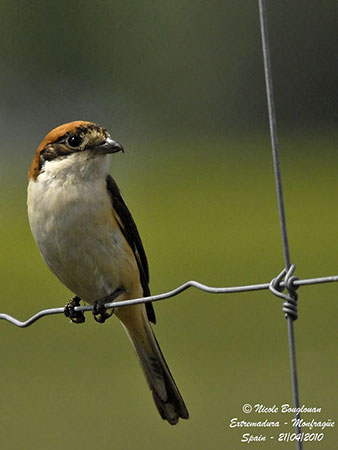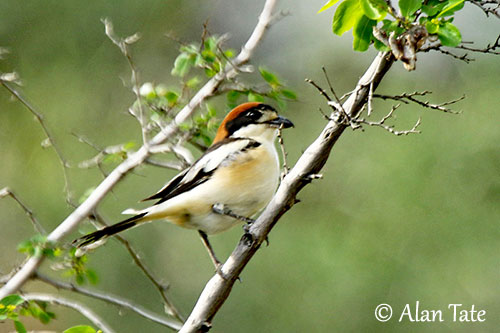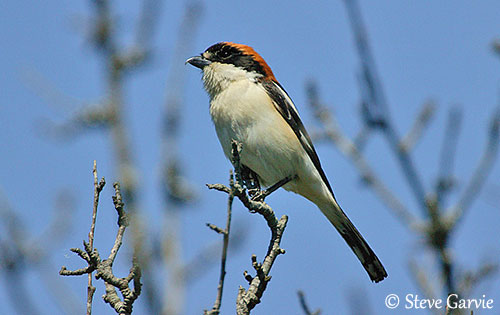
Fr: Pie-grièche à tête rousse
Ang: Woodchat Shrike
All: Rotkopfwürger
Esp: Alcaudón Común
Ita: Averla capirossa
Nd: Roodkopklauwier
Sd: rödhuvad törnskata
Photographers:
John Anderson
John Anderson Photo Galleries
Steve Garvie
RAINBIRDER Photo galleries & Flickr Rainbirder
Otto Plantema
Trips around the world
William Price
PBase-tereksandpiper & Flickr William Price
Alan & Ann Tate
AA Bird Photography
Ingo Waschkies
Bird Photography
Nicole Bouglouan
Photographic ramble & My Spanish Gallery
Text by Nicole Bouglouan
Sources:
HANDBOOK OF THE BIRDS OF THE WORLD Vol 13 by Josep del Hoyo-Andrew Elliot-Jordi Sargatal - Lynx Edicions – ISBN: 9788496553453
THE HANDBOOK OF BIRD IDENTIFICATION FOR EUROPE AND THE WESTERN PALEARCTIC by Mark Beaman, Steve Madge - C. Helm - ISBN: 0713639601
Flight Identification of European Passerines and Select Landbirds: An Illustrated and Photographic Guide by Tomasz Cofta – Photos de Michał Skakuj – Editeur: Princeton University Press, 2021 – ISBN: 0691177570, 9780691177571 – 496 pages
Shrikes De Norbert Lefranc – Editeur : A&C Black, 2013 – ISBN : 1408187566, 9781408187562 – 192 pages
IDENTIFICATION PITFALLS AND ASSESSMENT PROBLEMS
Pájaros de España (JL Beamonte)
Identification of Lanius senator badius
Identification of eastern Woodchat Shrike Lanius senator niloticus
Wikipedia, the free encyclopaedia
Home page
Page Passeriformes Order
Woodchat Shrike
Lanius senator
Passeriformes Order – Laniidae Family
INTRODUCTION:
The Woodchat Shrike is found in southern Europe, N Africa and the Middle East where it breeds, whereas it winters is tropical Africa. Three subspecies share the large range and all are migratory.
The Woodchat Shrike breeds in warm, open or semi-open areas, but in the African winter range, it mostly frequents dry Acacia savanna and flat, cultivated areas with trees.
It feeds primarily on insects of various species, spiders, small vertebrates, lizards and frogs, and sometimes young passerines or exhausted migrating birds.
The species is monogamous, solitary nester and territorial. Both adults share the nesting duties except incubation. The nest is an open cup usually built on lateral tree branch.
The Woodchat Shrike is threatened by degradation and habitat loss. The species is currently listed as Near Threatened.

DESCRIPTION OF THE BIRD:
Biometrics:
Length: 18-19 cm
Wingspan: 25-27 cm
Weight: 33-45 g
The Woodchat Shrike adult male of nominate race has rufous crown to upper mantle, whereas lower mantle and back are black. The scapulars are white. The upperwing is dark brown, with a white patch at primary bases. Both rump and uppertail-coverts are white. The tail is black, but the central rectrices are tipped white, whereas the outermost feathers are white with some black on the inner web.
Below, throat and underparts are white, but we can see a creamy-buff tinge in fresh plumage.
On the head, forehead and facial mask to ear-coverts and rear of neck-sides are black. The short-whitish supercilium is usually indistinct. Crown and nape are rufous.
The bill is black. The eyes are more or less dark brown. Legs and feet are blackish.
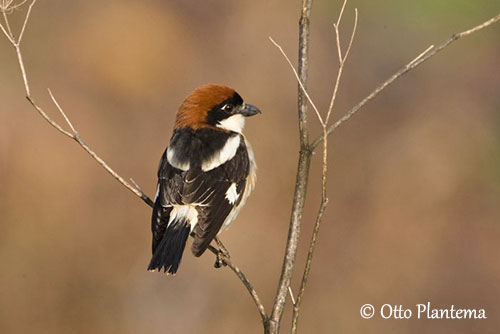
The adult female resembles male but she is duller overall. On the head, the white patch over the bill extends back to the eye.
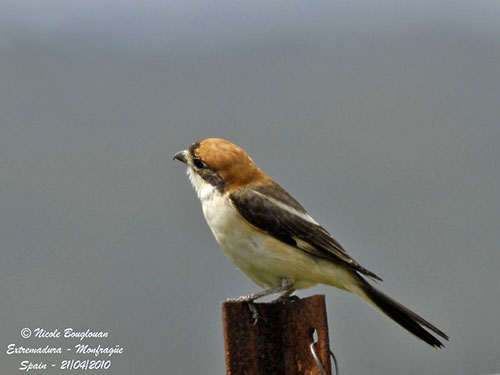
The juvenile has forehead to back rufous-buff, becoming greyish, with dark brown and white barring. The scapulars are whitish. On the upperwing, the wing-coverts show pale buffish edges and buff wing patch. On the tail, the outermost rectrices are buff-white.
The underparts are whitish with grey-brown crescent markings.The bill is dark grey with flesh-grey lower mandible.
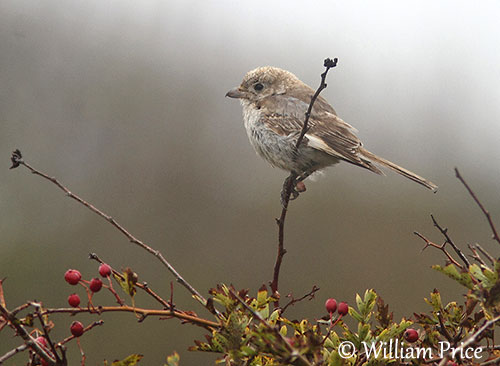
SUBSPECIES AND RANGE:
The Woodchat Shrike has three subspecies.
L.s. senator (described above) is found in Europe, from Spain to W Turkey and in N Africa. It winters in C Africa.
L.s. badius occurs in W Mediterranean islands, and winters in W Africa.
This race differs from nominate by narrower, black forehead and a restricted white area on primary bases, often hidden.
L.s. niloticus is found in E Turkey to Iran. It winters in E Africa.
This one has white of rump extending on to tail base. The white primary patch is broader than in nominate race.
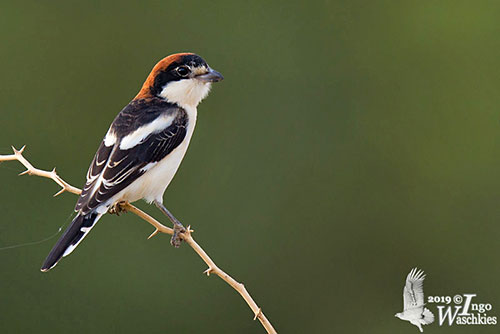
HABITAT:
The Woodchat Shrike breeds in warm, open and semi-open areas. However, both nominate and race “niloticus” breed in very open grassy scrublands with higher bushes or trees.
The species is confined to lowlands, plains or hills, up to 600-900 metres of elevation. But in the southern parts of the range, it can be seen on well-exposed slopes and at higher elevations. In the north of the breeding range, it occurs in old orchards when sheep and cattle are present. It hunts in areas with short vegetation.
During the winter in Africa, it is mainly found in dry Acacia savanna, and also in flat, cultivated areas with scattered trees.
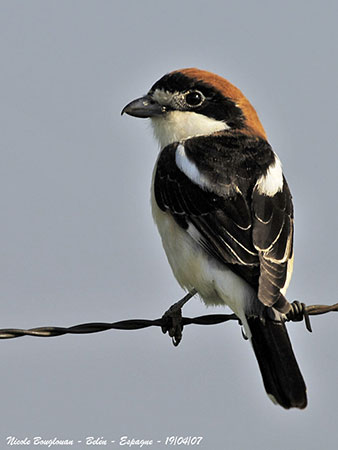
CALLS AND SONGS: SOUNDS BY XENO-CANTO
The Woodchat Shrike’s contact call is a “kwikwik” or “pitquür”. When the bird is excited, it gives a typical short “crex” and other calls described as “gek gek gek” can also be heard. A rattling bill-snapping “trr trr trr” is given during disputes with rivals or against nest-predators. This call is common to other Lanius species.
The song is usually louder than in other W Palearctic shrikes, and it may sometimes be heard during winter. It is described as a continuous warbler including both musical and harsh notes, and numerous good imitations of other bird songs. The female also sings, and duets have been heard.
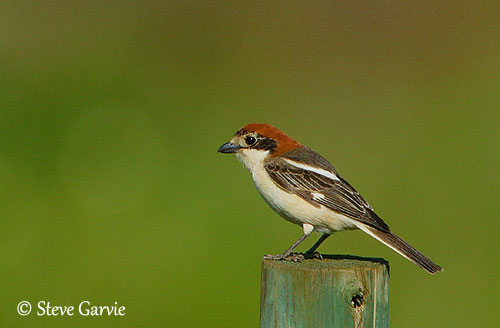
BEHAVIOUR IN THE WILD:
The Woodchat Shrike feeds primarily on insects including Coleopterans and Orthopterans, but insect species vary depending on the range.
Other species are less frequently taken such as Hymenoptera, Lepidoptera, Hemiptera, Diptera, Odonata and others. It also takes spiders, earthworms and snails in rainy conditions.
But the Woodchat Shrike also catches small vertebrates such as voles, mice, lizards and frogs. It may take small passerines, mainly young ones, and also exhausted migrating birds.
Some plant material including mulberries of genus Morus, and berries of Prunus mahaleb are also part of its diet in Crete and South of France.
The hunting behaviour of the Woodchat Shrike is typical. The bird perches on exposed place from which it drops or glides down on to a prey on the ground. It may also perform sallying flights to catch aerial insects.
The prey are then impaled on thorns or barbed wires used as “larders”, but this behaviour is relatively unusual. The larger insects are dismembered while the small ones are crushed.
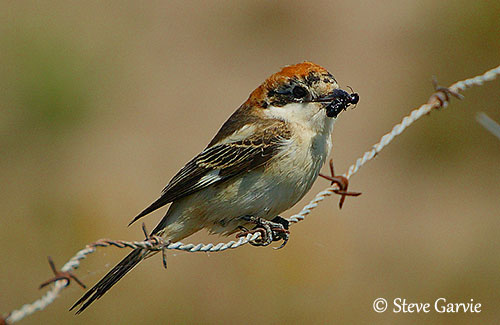
Male and female are usually seen together when they appear in their breeding territory, being apparently already paired. The pair formation probably takes place during migration stop-over or even in the wintering areas or just after arrival.
The Woodchat Shrike is monogamous, solitary nester and territorial, although several nests may sometimes be clustered, but only occasionally.
Both adults build the nest, a compact bowl placed on lateral branch of tree. Except for the incubation performed by the female alone, both adults share the nesting duties.
The Woodchat Shrike is migratory. The three races spend the winter in sub-Saharan Africa.
The birds leave their breeding grounds in the second half of August or early September, usually adults before juveniles.
They leave the wintering areas between February and May.
The species is an annual vagrant NW to Britain and Ireland, often in May/June. It is rare in Norway and Sweden, and there was a single record in India in September.
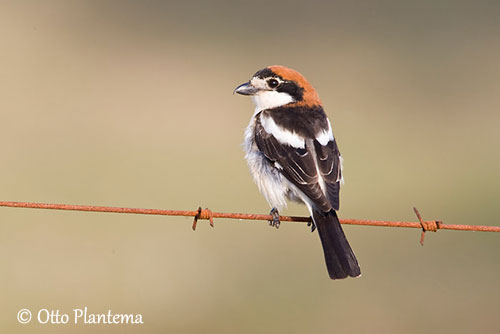
The flight of the Woodchat Shrike is fast, direct and agile, graceful and sweeping. The wingbeats are slow, deep and easy, rather floppy. They are interspersed with short, non-flapping intervals and the bird may glides sometimes. While hunting, the bird is able to hover.
They migrate as single individuals.
REPRODUCTION OF THIS SPECIES:
The laying takes place from early May to late June in C Europe, but from April in N Africa and from March in Israel.
The species usually lays two broods in Africa and Israel, but this is exceptional in Europe.
The male chooses the nest-site and starts to build the nest, and the female helps her mate 1-2 days later. This work may last 4-6 days.
The nest is usually placed towards the end of a thick horizontal branch, sometimes in a fork, an angled branch or in outer twigs, usually between 1 and 20 metres above the ground.
It is a compact, open cup made with twigs and roots and various plant materials, including green parts of vegetation. The cup is lined with softer material such as rootlets, hair, wool, moss, lichens and spider web. In Europe, it is often placed 4-5 metres above the ground, and low down in dense bush in the Mediterranean region.
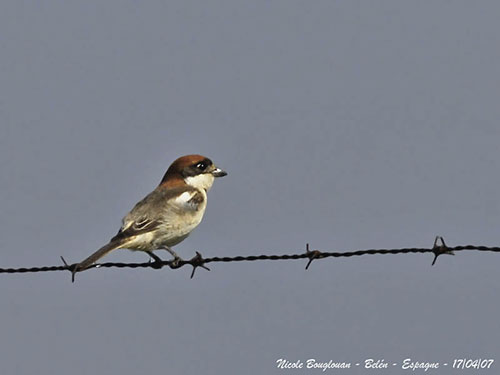
The female lays 4-8 pale green, to olive-green, sandy or greyish-yellow eggs with brownish speckles. A replacement clutch may be laid to mid-July if the first brood is lost.
The incubation lasts 14-16 days, performed by the female alone, but she is fed on the nest by the male. The female broods the chicks, but the young are fed by both parents. The nestling period lasts 15-18 days, but the chicks are able to jump from the nest 12 days after hatching if they are disturbed.
Both parents feed the juveniles for up to 6 weeks after fledging.
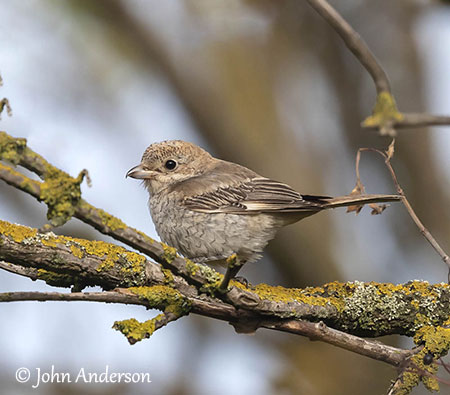
PROTECTION / THREATS / STATUS:
The Woodchat Shrike is threatened by degradation and loss of the habitat, caused by agriculture expansion, afforestation and fires. Heavy use of pesticides and herbicides are also important threats.
Other problems such as climatic changes that reduce the range, hunting in Italy in summer and during migration, and decline of insect populations also affect this species.
The European population was estimated to number 3,860,000 / 6,240,000 mature individuals in 2021. As Europe forms 65% of the global range, a preliminary estimate of the global population size is 5,940,000 / 9,610,000 mature individuals. There is a continuing decline in the global numbers.
The Woodchat Shrike is currently listed as Near Threatened.
